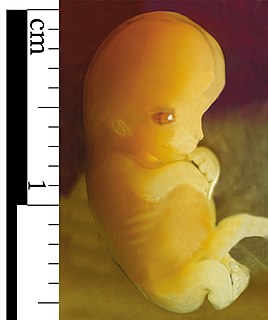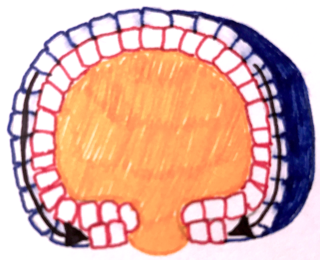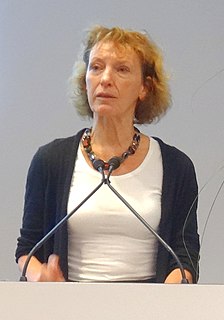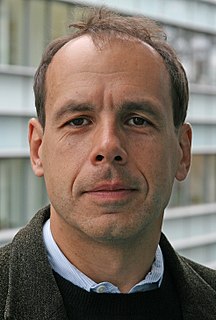
An embryo is an initial stage of development of a multicellular organism. In organisms that reproduce sexually, embryonic development is the part of the life cycle that begins just after fertilization of the female egg cell by the male sperm cell. The resulting fusion of these two cells produces a single-celled zygote that undergoes many cell divisions that produce cells known as blastomeres. The blastomeres are arranged as a solid ball that when reaching a certain size, called a morula, takes in fluid to create a cavity called a blastocoel. The structure is then termed a blastula, or a blastocyst in mammals.

Christiane (Janni) Nüsslein-Volhard is a German developmental biologist and a 1995 Nobel Prize in Physiology or Medicine laureate. She is the only woman from Germany to have received a Nobel Prize in the sciences.

Epiboly describes one of the five major types of cell movements that occur in the Gastrulation stage of embryonic development of some organisms. Epibolic movement is the way in which a layer of epithelial cells spreads. This can be achieved in multiple ways.

The development of fishes is unique in some specific aspects compared to the development of other animals.

G protein-coupled receptor 126 also known as VIGR and DREG is a protein encoded by the ADGRG6 gene. GPR126 is a member of the adhesion GPCR family. Adhesion GPCRs are characterized by an extended extracellular region often possessing N-terminal protein modules that is linked to a TM7 region via a domain known as the GPCR-Autoproteolysis INducing (GAIN) domain.

Nodal homolog is a secretory protein that in humans is encoded by the NODAL gene which is located on chromosome 10q22.1. It belongs to the transforming growth factor beta (TGF-β) superfamily. Like many other members of this superfamily it is involved in cell differentiation in early embryogenesis, playing a key role in signal transfer from the primitive node, in the anterior primitive streak, to lateral plate mesoderm (LPM).

Anthony Arie Hyman FRS is a British scientist and director at the Max Planck Institute of Molecular Cell Biology and Genetics.
The clock and wavefront model is a model used to describe the process of somitogenesis in vertebrates. Somitogenesis is the process by which somites, blocks of mesoderm that give rise to a variety of connective tissues, are formed.

Maria Leptin is a German developmental biologist and immunologist, and the current President of the European Research Council. She was the Director of the European Molecular Biology Organization from 2010 to 2021.

Alexander F. Schier is a Professor of Cell Biology and the Director of the Biozentrum University of Basel, Switzerland.

Sir James Cuthbert Smith is Director of Science at the Wellcome Trust and Senior Group Leader at the Francis Crick Institute.

Homeotic protein bicoid is encoded by the bcd maternal effect gene in Drosophilia. Homeotic protein bicoid concentration gradient patterns the anterior-posterior (A-P) axis during Drosophila embryogenesis. Bicoid was the first protein demonstrated to act as a morphogen. Although bicoid is important for the development of Drosophila and other higher dipterans, it is absent from most other insects, where its role is accomplished by other genes.
Ruth Lehmann is a developmental and cell biologist. She is the Director of the Whitehead Institute for Biomedical Research, succeeding David Page. She previously was affiliated with the New York University School of Medicine, where she was the Director of the Skirball Institute of Biomolecular Medicine, the Laura and Isaac Perlmutter Professor of Cell Biology, and the Chair of the Department of Cell Biology. Her research focuses on germ cells and embryogenesis.
Evx1 is a mammalian gene located downstream of the HoxA cluster, which encodes for a homeobox transcription factor. Evx1 is a homolog of even-skipped (eve), which is a pair-rule gene that regulates body segmentation in Drosophila. The expression of Evx1 is developmentally regulated, displaying a biphasic expression pattern with peak expression in the primitive streak during gastrulation and in interneurons during neural development. Evx1 has been shown to regulate anterior-posterior patterning during gastrulation by acting as a downstream effector of the Wnt and BMP signalling pathways. It is also a critical regulator of interneuron identity.
Sanjeev Anant Galande is an Indian cell biologist, epigeneticist, academic, former Chair of Biology and the Dean of Research and Development at the Indian Institute of Science Education and Research, Pune He heads the Laboratory of Chromatin Biology and Epigenetics at Indian Institute of Science Education and Research, Pune. He is the founder of the Centre of Excellence in Epigenetics at IISER Pune and is known for his studies on higher-order chromatin architecture and how it influences spatiotemporal changes in gene expression. He is an elected fellow of the Indian National Science Academy and the Indian Academy of Sciences and a recipient of the National Bioscience Award for Career Development of the Department of Biotechnology. The Council of Scientific and Industrial Research, the apex agency of the Government of India for scientific research, awarded him the Shanti Swarup Bhatnagar Prize for Science and Technology, one of the highest Indian science awards, in 2010, for his contributions to biological sciences.

Didier Stainier is a Belgian/American developmental geneticist who is currently a director at the Max Planck Institute for Heart and Lung Research in Bad Nauheim, Germany.

Spätzle or spaetzle is an evolutionarily-conserved arthropod protein first identified in Drosophila melanogaster. It plays a role in embryonic development and in the insect innate immune response. The name was coined by the Nobel laureate Christiane Nüsslein-Volhard after the Spätzle noodle-like form of homozygous mutant fly larvae.
Gerald "Gerry" Downes is an associate professor in biology at the University of Massachusetts, Amherst. His research expertise is in the genetic requirements for zebrafish swimming. Recently he has expanded his research interests into using the zebrafish system to model idiopathic epilepsy syndromes.
Makoto Furutani-Seiki is Director of UK Research Centre for Regenerative Medicine and Biochemistry Research Division, University of Bath, UK.

Corinne Houart is a Belgian biomedical scientist who is Professor of Developmental Biology at King's College London. She also serves as editor of the Centre for Developmental Neurobiology. She was elected to the European Molecular Biology Organization in 2021.













